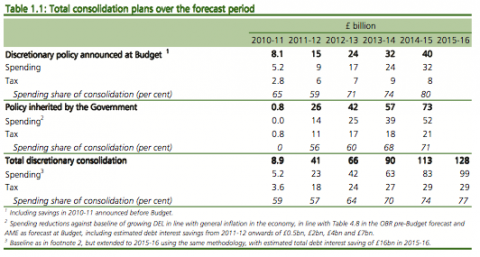Budget 2011: how do Labour and Coalition spending plans match up?
Dermot Murnhaghan: "[Under Labour's plans, there was] only £2 billion in the next fiscal year difference from the Tory cuts that are coming."
Peter Hain: "No, there is a £40 billion difference in the scale and the depth of the cuts that they are doing, that's a massive amount and that is what is causing the misery."
Sky News, 27 March 2011
Join 72,953 people who trust us to check the facts
Sign up to get weekly updates on politics, immigration, health and more.
Subscribe to weekly email newsletters from Full Fact for updates on politics, immigration, health and more. Our fact checks are free to read but not to produce, so you will also get occasional emails about fundraising and other ways you can help. You can unsubscribe at any time. For more information about how we use your data see our Privacy Policy.
The decision by Labour Leader Ed Miliband to speak at Saturday's march for an "alternative to cuts" has prompted a closer inspection of just what the alternative is that his party is offering.
The Shadow Welsh Secretary Peter Hain was one of those questioned on the Opposition's spending proposals yesterday, challenging the idea that there was only £2 billion difference between Labour's policies and those being pursued by the coalition.
So is he right to place the figure closer to the £40 billion mark?
Labour's leadership has do far indicated that, if in Government, it would stick to plans outlined in its last Budget of March 2010, in which it set out its ambition to halve the deficit over four years — the so-called "Darling plan."
Using this as the point of reference for the subsequent plans set out by the Coalition Government's Budgets of June 2010 and March 2011, we can see that both Mr Murnaghan and Mr Hain have some grounds for making the claims they do, although neither's figures are exactly borne out by the past three Budgets.
In the coming fiscal year — 2011/12 — the difference between the present Government's spending plans and those of its predecessor is £5.3 billion, substantially more than the £2 billion proposed by Mr Murnaghan, but still closer to his figure than the £40 billion proffered by Mr Hain.
However looking at the entire spending period covered by both the March 2010 and 2011 Budgets, the difference between Labour and Coalition spending plans grows over time, meaning that by 2014/15 there a £30.4 billion gap emerges (the estimate in the June 2010 Budget placed the figure at £32.3 billion). This is closer to the £40 billion proffered by Mr Hain.

However the £40 billion figure is one used in the June 2010 Budget to describe the difference in Labour and Coalition consolidation plans, but to reach this number we need to include the extra £8 billion raised in taxes under the Coalition's proposals. Furthermore, since last week's Budget, the total difference in the fiscal consolidation plans has reduced slightly to £38 billion.

So whilst neither Mr Murnaghan nor Mr Hain's figures match up entirely with the Government's own calculations, both have some grounds for their assertions. The difference between Labour and Coalition spending plans over the next financial year, at a little over £5 billion, are certainly closer to the estimate given by the Sky presenter. However Mr Hain's figure of £40 billion is much closer to the eventual difference between the two plans at the end of the current Parliament.